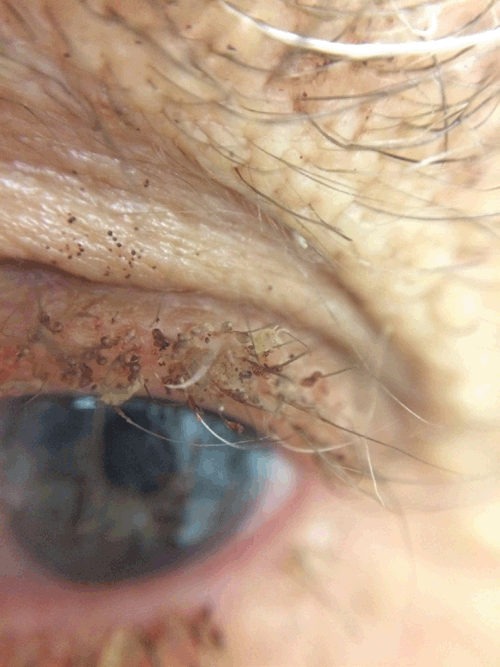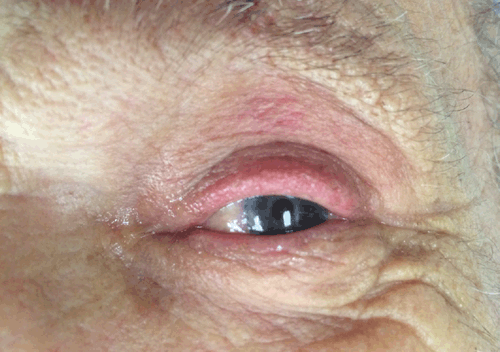Phthiriasis palpebrarum: an uncommon cause of ocular irritation
Lucy M. Lu1 Department of Ophthalmology, Waikato Hospital, Waikato District Health Board, Hamilton, New Zealand
Correspondence to: Lucy Lu, Department of Ophthalmology, Waikato Hospital, Waikato District Health Board, Hamilton, New Zealand. Email: lucymmlu@gmail.com
Journal of Primary Health Care 10(2) 174-175 https://doi.org/10.1071/HC17070
Published: 19 June 2018
Journal Compilation © Royal New Zealand College of General Practitioners 2018.
This is an open access article licensed under a Creative Commons Attribution-NonCommercial-NoDerivatives 4.0 International License.
Introduction
Phthiriasis palpebrarum is the infestation of the eyelids with Pthirus pubis, or pubic lice. This paper describes a case of Phthiriasis palpebrarum causing severe bilateral blepharitis. The aim is to highlight this uncommon but troublesome condition and to inform medical practitioners of treatment options.
Case report
A 74-year-old man was referred to the acute ophthalmology service from the Emergency Department for a 1-month history of bilateral gritty eyes with intermittent bleeding. He has a background of oesophageal adenocarcinoma on chemotherapy. The patient had consulted his GP, the oncology department staff, and the Emergency Department and was treated for blepharitis and conjunctivitis, but his eye problems did not improve with topical antibiotics and lubricants.
On examination, he had crusting and dried blood around his eyelids. Slit lamp examination revealed live lice and nits attached to his lashes and eyebrow hairs. These were visible even with the naked eye (shown in Figure 1). He had resultant severe blepharitis. His vision was unaffected. He denied symptoms in any other areas of hair growth, including his pubic region.

|
This patient was treated in the eye clinic by immersing the eyelashes and eyebrows with chloramphenicol ointment for 30 min to suffocate the lice, then mechanically epilating all eyelashes with forceps. The eyebrows were trimmed and the nits were removed from individual hairs. This was done under direct vision with the patient lying down. Figure 2 depicts the appearance immediately after treatment. The patient was prescribed Chlorsig for his lashes and brows three times a day plus at bedtime for 2 weeks, to kill any remaining nits that would have hatched within this time. His oncologist was informed and it was decided that chemotherapy would be put on hold due to possible skin side-effects and increased risk of secondary infection.

|
The patient returned for review 2 weeks later and was completely free of symptoms. Thorough slit lamp examination revealed no further lice or nits remaining on his eyelashes or eyebrows, and he was discharged and cleared to recommence chemotherapy.
Discussion
Phthiriasis palpebrarum is an uncommon cause of blepharoconjunctivitis that can be missed without close examination. It is resistant to routine treatment for blepharitis or conjunctivitis; therefore, it should be considered in someone with chronic bilateral symptoms not responding to treatment.
The causative organism is Pthirus pubis, commonly known as pubic lice or crabs. This is a distinct species from hair or body lice.1 It is typically transmitted sexually from the pubic region to the eyelashes; therefore, sensitive history taking that includes a social and sexual history is necessary, and full examination of the body is indicated. Contact tracing and screening for other venereal infections may also be indicated.
Importantly, when this condition is found in children, the possibility of sexual abuse must be considered, as it is most commonly transmitted from close contact with an adult.2 Eyelash lice has been reported in children as young as a 21-day-old infant.3 Treatment and complete eradication is challenging in low socioeconomic families living in overcrowded homes.
There are several effective treatment options. Mechanical removal is the most definitive treatment but this can be time-consuming and difficult. Lashes can take up to 6 months to grow back. Completely epilating the eyelashes can be painful and cosmetically undesirable, particularly for younger patients; therefore, an alternative is cutting the eyelashes or removing the nits from individual hairs with forceps without plucking out the hair. Occlusive agents such as antibiotic ointment or Vaseline can be used alone or in conjunction with mechanical removal and should be continued for at least 2 weeks. Pilocarpine 4% gel has been used for its anticholinergic pediculocidal and occlusive effect.4 Oral ivermectin is an anthelmintic that kills lice by blocking their peripheral neuromuscular system thus paralysing them. Two doses of 200 micrograms/kg a week apart have been shown to achieve complete eradication of eyelash lice.5 This option may be suitable for individuals intolerant to local treatment or if multiple body areas are affected. However, ivermectin cannot be used for individuals weighing less than 15 kg and should be used with caution in pregnant women.5
Adult lice cannot survive for more than 48 h when separated from the host, and nits hatch in 7–10 days. Clothing, towels and bedding used by the patient should be machine washed at ≥ 55°C for 30 min. Items that cannot be washed can be sealed in a plastic bag for 2 weeks.6
In general practice, Chlorsig ointment, which is cheap and widely available, combined with mechanical removal of nits is a convenient and definitive treatment, and can be carried out in one or two clinic sessions. Where a slit lamp is not available, it can be performed with the naked eye or with magnifying loupes. Topical anaesthetic drops should be applied to the eyes to assist comfort. Alternatively, a referral to the local optometrist or ophthalmology clinic can be made. It is important to pay attention to personal hygiene and sexual history and treat other infections, particularly in children, the elderly or the immunocompromised.
COMPETING INTERESTS
None.
References
[1] de Pinho Paes Barreto R, Biancardi AL, Salgueiro MJ. Chronic conjunctivitis related to Phthiriasis palpebrarum. Int Ophthalmol. 2012; 32 467–9.| Chronic conjunctivitis related to Phthiriasis palpebrarum.Crossref | GoogleScholarGoogle Scholar |
[2] Ryan MF. Phthiriasis palpebrarum infection: a concern for child abuse. J Emerg Med. 2014; 46 e159
| Phthiriasis palpebrarum infection: a concern for child abuse.Crossref | GoogleScholarGoogle Scholar |
[3] Ozer PA, Kabatas EU, Gurkan A, Kurtul BE. Treatment of Phthiriasis palpebrarum mimicking conjunctivitis in a newborn. Indian J Pediatr. 2016; 83 730–1.
| Treatment of Phthiriasis palpebrarum mimicking conjunctivitis in a newborn.Crossref | GoogleScholarGoogle Scholar |
[4] Kumar N, Dong B, Jenkins C. Pubic lice effectively treated with Pilogel. Eye (Lond). 2003; 17 538–9.
| Pubic lice effectively treated with Pilogel.Crossref | GoogleScholarGoogle Scholar |
[5] Burkhart CN, Burkhart CG. Oral ivermectin therapy for Phthiriasis palpebrum. Arch Ophthalmol. 2000; 18 134–5.
[6] Panos GD, Petropoulos IK, Dardabounis D, Gatzioufas Z. Phthiriasis palpebrarum. BMJ Case Rep. 2013;
| Phthiriasis palpebrarum.Crossref | GoogleScholarGoogle Scholar |


